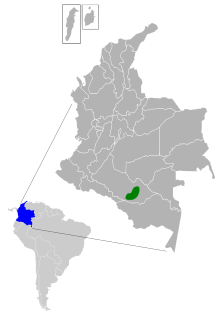Chiribiquete emerald hummingbird
| Chiribiquete emerald hummingbird | ||||||||||
|---|---|---|---|---|---|---|---|---|---|---|
| Systematics | ||||||||||
|
||||||||||
| Scientific name | ||||||||||
| Chlorostilbon olivaresi | ||||||||||
| Stiles , 1996 |
The Chiribiquete emerald hummingbird ( Chlorostilbon olivaresi ) is a species of bird in the hummingbird family (Trochilidae). The species has a range that covers about 6,600 square kilometers in the South American country Colombia . The IUCN assesses the population as not at risk ( least concern ).
features
The Chiribiquete emerald hummingbird reaches a body length of about 8 centimeters. The beak length ( culmen ) is 21.8 millimeters. The wing depth is about 5 centimeters, the tail length 2.6 centimeters and the stilt ( tarsus ) 4.4 millimeters. It weighs around 3.4 grams. The crown, nape, back and rump of the male are metallic green. The front part of the parting shimmers golden green. Postocular (behind the eyes) there is a small gray-white spot. The upper part of the tail is blue-green and turns dark steel blue downwards. The face and side neck are emerald green with light green reflections. From the throat to the upper chest, the color turns abruptly into blue-green. Towards the lower chest and stomach it is emerald green again. There is a small white tuft on the thigh. The lower jaw is red while the rest of the beak, as well as all of the legs, are black. In contrast to the male, the lower part of the female is bronze-green. The female has bruises on her back, making her look slightly scaly. The inner control springs are blue and become dark blue on the outside. The outer feathers contain light gray speckles. The cheeks and the ear area are soot gray with dark bronze tints. The lower part is pale gray to brownish.
Habitat
The hummingbird is native to the Serranía de Chiribiquete . There are some in the area of sandstone - mesas . The flora is dominated by Bonnetia martiana (from the family Tea Family ) clusia chiribiquensis (from the family hypericaceae ) Tepuianthus savannensis (from the family of Thymelaeaceae ) Graffenriedia (from the family of melastomataceae ) and Decagonocarpus cornutus (from the family of Rutaceae ). The hummingbird prefers to roam in the bushes of the Bonnetia , but it also likes to hang around the red-orange flowers of the Decagonocarpus cornutus . Sometimes you can see him on rocky outcrops that are lined with forest. Here, too, he is mainly in the undergrowth. The bird moves at heights between 300 and 900 meters. You won't find it in the surrounding wooded lowlands around the table mountains.
behavior
The hummingbird usually gets its nectar from the flowers of the Decagonocarpus cornutus . He collects small arthropods in the leaves and flowers of the Bonnetia and other bushes . It also catches insects in flight. Its prey includes fringed winged flies , flies and hymenoptera . The breeding season is from November to December and probably in May. The hummingbird has been observed to molt by around the end of July .
Subspecies
So far, no subspecies of the Chiribiquete emerald hummingbird is known. The species is therefore considered to be monotypical . The species used to be considered a subspecies of the blue-tailed emerald hummingbird ( Chlorostilbon mellisugus ). In 2003 has South American Check-list Committee , among other Chlorostilbon olivaresi recognized as a separate species.
Etymology and history of research
The type specimen for the first description was collected on November 24, 1992 by Stiles, José Luis Tellería and Mario Díaz Esteban in the Valle de los Menhires in the Serranía de Chiribiquete.
The word Chlorostilbon is made up of the Greek words "chlōros χλωρός " for "green" and "stilbōn στίλβων " for "shining". The Greeks gave Mercury the nickname Stilbōn, which is due to the verb "stilb" for "blink". The new species was named by Frank Gary Stiles in honor of Fray Antonio Olivares Celis , whom he calls a pioneer of Colombian ornithology and who played a major role in building up the bird collection of the Instituto de Ciencias Naturales .
literature
- Frank Gary Stiles: A New Species of the Emerald Hummingbird from the Sierra De Chribiquete, Southeastern Colombia, with a Review of the C. Mellisugus Complex . In: The Wilson Bulletin . tape 108 , no. 1 , 1996, p. 1–27 ( online [PDF; accessed January 29, 2013]). (PDF; 1.7 MB)
- James A. Jobling: Helm Dictionary of Scientific Bird Names . Christopher Helm, London 2010, ISBN 978-1-4081-2501-4 .
Web links
- Chlorostilbon olivaresi in the endangered Red List species the IUCN 2012. Posted by: BirdLife International, 2012.2. Retrieved April 10, 2013.
- BirdLife International: Species Factsheet - Chiribiquete Emerald ( Chlorostilbon olivaresi ) . Retrieved April 10, 2013.
- Videos, photos and sound recordings for Chiribiquete Emerald (Chlorostilbon olivaresi) in the Internet Bird Collection
- Chiribiquete emerald hummingbird ( Chlorostilbon olivaresi ) at Avibase; Retrieved April 10, 2013.
- Chlorostilbon olivaresi in the Integrated Taxonomic Information System (ITIS). Retrieved April 10, 2013.
- xeno-canto: sound recordings - Chiribiquete Emerald ( Chlorostilbon olivaresi )
- Chiribiquete emerald hummingbird (Chlorostilbon olivaresi) in the Encyclopedia of Life . Retrieved August 28, 2017.
Individual evidence
- ↑ a b Frank Gary Stiles, p. 4f
- ^ IOC World Bird List Hummingbirds
- ^ Proposal (# 54) to South American Check-list Committee
- ^ Frank Gary Stiles, p. 3
- ↑ James A. Jobling, p. 103
